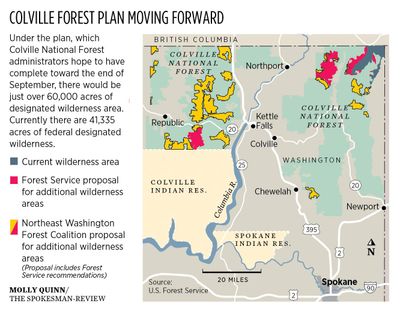After nearly two decades, Colville Forest plan coming to a close

A nearly two-decade long process determining the style and scope of management on the 1.1 million-acre Colville National Forest will come to a close this fall.
About 60,000 acres of the 1.1 million-acre forest in northeast Washington will be designated wilderness area, despite widespread support for a larger designation.
According to Jennifer Knutson, a spokeswoman for the Forest Service, the process could be complete “at the earliest” in September.
To the surprise of conservation groups and one of the area’s largest timber producers, the Forest Service draft plan, first released in September, proposed that about 60,000 acres of the Colville National Forest be designated as recommended wilderness. A coalition, which represented environmental, industrial and recreation interests, originally asked for more than 200,000 acres.
This spring 20 objections, filed by eight groups, were submitted in response to the forest’s draft management plan.
Many of those objections dealt with the wilderness designation.
On July 3, a letter responding to objections raised by various groups earlier in the year was published, directing the Forest Service to make some changes, and move forward, without the expanded wilderness designation.
“The group (Tri-County Forestry Group) was unable to reach consensus,” wrote objection reviewer Allen Rowley of the Forest Service. “Therefore, I am not instructing the Region/Forest to modify any boundaries.”
The Tri-County Forestry group is made up of representatives from Ferry, Stevens and Pend Oreille counties.
“We couldn’t come to a consensus about agreeing on which areas should be recommended wilderness,” said Mike Petersen, the executive director of the Spokane-based Lands Council and a member of the group.
In particular, elected officials from those three counties have been adamantly against wilderness designation. In a previous interview Stevens County Commissioner Don Dashiell said “Our intention is to object to any designations of wilderness beyond what’s already in the forest.”
The Colville National Forest has one federally designated wilderness area – the 41,335-acre Salmo-Priest Wilderness – which represents 3 percent of the Colville National Forest’s 1.1 million acres.
“They have a measly amount of wilderness (in the plan),” said Tiana Luke, a Conservation Northwest staff member based in northeast Washington.
Luke said the lack of wilderness designation was disappointing because of the broad support from disparate groups for expanded wilderness. Plus, innovative policies on the Colville Forest have allowed increased logging and building new trails for mountain bikers, motorcyclists and ATV riders, who would lose access to some trails if Congress approved new wilderness.
“The conservation goals, such as wilderness, we haven’t moved that far on those,” Luke said.
Tim Coleman, the executive director of the Kettle Range Conservation Group, has worked on the forest plan since the process started in 2003. The plan’s direction disappoints him.
“It doesn’t provide any additional safeguards than what we have right now,” he said.
Wilderness areas such as the Salmo-Priest must be created by an act of Congress. However, recommended wilderness areas have management restrictions other areas don’t. For instance, Forest Service personnel and volunteer groups can use chain saws to thin trees. In a federally designated wilderness, chain saws are prohibited. Additionally, mineral leasing is possible in recommended wilderness areas.
Luke said Conservation Northwest and others will continue to pursue federal wilderness designation.
Despite the restrictions on wilderness, Forest Service personnel do manage forest fires in both recommended and designated wilderness areas, despite a popular misconception that they can’t. For instance, the Forest Service sent smoke jumpers into the Salmo-Priest Wilderness area to fight a forest fire in 2017. They had chain saws but were forced to retreat when it became too dangerous.
Washington State has a total of 4.5 million acres of federally designated wilderness.
The lack of proposed wilderness could also impact recreation, and by extension, the area economy, said Bobby Whittaker, a recreation proponent and organizer who lives in Republic.
“Right now I’m disappointed with the lack of wilderness,” he said. “It’s so critical on top of all of the forestry success. We need recreation success and we get that through proper designations. We need a large area of well defined wilderness that is accessible. Just as much as we need areas for mountain bikes and motorized recreation.”
Forest plans are intended to last for 15 years, although most plans remain in place much longer. The current Colville Forest management plan was drafted in 1988, with the review process starting in 2003.
While the lack of wilderness is disappointing, the plan has some bright spots, said Luke with Conservation Northwest. For instance, the plan dictates that the forest management will be “restoration based.”
“Instead of looking at the forest from its individual stands … we look more at the landscape,” she said. “Say 30,000 acres.”
That big-picture approach is important to building healthy forests and ecosystems. And, the plan allows for more active fire management including controlled burning.
“Despite its shortcomings, the revised Forest Plan is an overall improvement for management on the Colville National Forest,” Luke wrote in a blog post. “For instance, the plan allows greater use of fire, both natural and controlled or prescribed burning, to help restore the forest.”
And, the plan does offer additional protections to riparian areas, particularly from livestock, Coleman said.